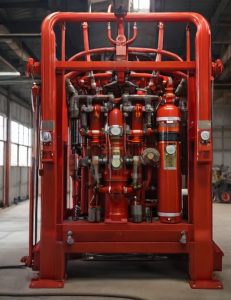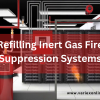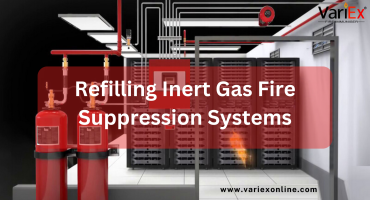![]()
Fire Immuniser
+91-7829629111
Email: info@variex.in
Varistor Technologies Pvt. Ltd.
Block-1, First Floor, Ardente Office One, Hoodi Circle, ITPL Main Road, Bengaluru, Karnataka 560048, IN
Air Release Valve In Fire Fighting System
In the realm of fire safety, every component of a fire fighting system plays a crucial role in ensuring effective operation. Among these components, air release valves hold particular importance, facilitating the efficient performance of fire suppression systems. This article delves into the significance of air release valves in fire fighting systems, exploring their functionality, benefits, and key considerations.
Understanding Air Release Valves: Air release valves are integral components of fire fighting systems, designed to automatically release trapped air from pipelines. Trapped air can hinder the flow of water within the system, compromising its ability to suppress fires effectively. Air release valves prevent the accumulation of air pockets by allowing trapped air to escape, ensuring uninterrupted water flow and optimal system performance.
Functionality and Operation: The operation of air release valves is relatively straightforward yet essential for maintaining system efficiency. When water flows through the pipeline, air release valves detect the presence of trapped air. Once identified, the valves open, allowing the air to escape and preventing air lock within the system. This continuous process ensures that water can flow freely, reaching its intended destination without obstruction.
Benefits of Air Release Valves:
The inclusion of air release valves in fire fighting systems offers several benefits:
- Improved System Efficiency: By preventing air lock and maintaining continuous water flow, air release valves enhance the overall efficiency of fire suppression systems.
- Reduced Maintenance Requirements: Properly functioning air release valves help minimize corrosion and damage caused by trapped air, reducing the need for frequent maintenance and repairs.
- Enhanced Fire Suppression Capability: Uninterrupted water flow ensures timely response to fires, maximizing the effectiveness of fire fighting efforts and minimizing potential damage.
- Extended Equipment Lifespan: By reducing strain on pumps and other system components, air release valves contribute to prolonging the lifespan of fire fighting equipment, resulting in long-term cost savings.
Key Considerations: When incorporating air release valves into fire fighting systems, stakeholders should consider several key factors:
- Proper Sizing: Selecting air release valves of appropriate size and capacity ensures compatibility with the system's flow requirements.
- Location and Placement: Position air release valves strategically along the pipeline to effectively release trapped air and maintain water flow.
- Maintenance and Inspection: Regular maintenance and inspection of air release valves are essential to ensure they remain in optimal working condition and continue to perform reliably during emergency situations.
Conclusion:
In fire safety, every component of a fire fighting system is crucial for effective operation. Air release valves prevent air lock and maintain water flow, maximizing system efficiency. Understanding their benefits and considerations ensures reliable fire fighting system operation, enhancing overall safety.
Frequently Asked Questions
What is an air release valve in a fire fighting system?
An air release valve is a component of a fire fighting system designed to automatically release trapped air from pipelines. This helps maintain uninterrupted water flow, ensuring the system's efficiency during fire suppression.
Why are air release valves important in fire fighting systems?
Air release valves are crucial in fire fighting systems as they prevent air lock, which can hinder water flow and compromise suppression effectiveness. By releasing trapped air, these valves ensure continuous water flow, maximizing the system's performance.
How do air release valves work in fire fighting systems?
Air release valves detect the presence of trapped air in pipelines. When identified, the valves open to allow the air to escape, preventing air lock and maintaining uninterrupted water flow within the system. This ensures timely response to fires and effective fire suppression.
Where are air release valves typically installed in fire fighting systems?
Typically, installers place air release valves at high points along the pipeline, where air tends to accumulate. They may also position them at strategic locations to ensure thorough air release and optimal water flow throughout the system.
Do air release valves require maintenance?
Yes, air release valves require regular maintenance to ensure they remain in optimal working condition. Routine inspections are necessary to check for proper operation and address any issues that may arise. Proper maintenance helps prolong the lifespan of air release valves and ensures their reliability during emergency situations.
Can air release valves be installed in existing fire fighting systems?
Yes, you can install air release valves in existing fire fighting systems to improve their efficiency and performance. However, it's essential to consider factors like system design, compatibility, and installation requirements for proper integration and functionality.
Are air release valves compatible with different types of fire fighting systems?
Air release valves are compatible with different fire fighting systems, like wet pipe, dry pipe, pre-action, and deluge systems. They adapt to various configurations, enhancing suppression effectiveness.
Do air release valves affect water pressure in fire fighting systems?
Properly sized and installed air release valves should not significantly affect water pressure in fire fighting systems. These valves are designed to release trapped air while maintaining adequate water pressure for effective fire suppression, ensuring optimal system performance.
Final Say
We at VariEx.in or Variexonline.com have mastered the art of designing, installing, inspecting, and fixing automatic sprinkler systems with the help of our in-house team, which is capable of delivering the fire sprinkler services you need, whether large or small and at affordable cost.
To schedule a fire sprinkler installation, or you think our services could benefit your commercial property, contact us online or give us a call at, 7829629111










